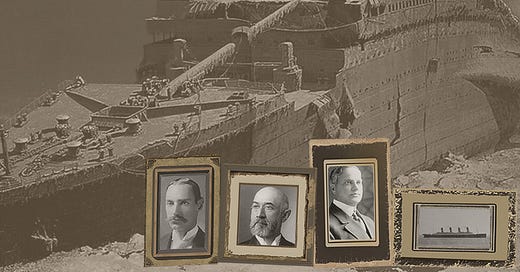The recent loss of the OceanGate Titan submersible along with its crew in the North Atlantic Ocean has caught the attention of media outlets around the world. The expedition had set out to explore the wreckage of the Titanic, which lies in two sections, some 3,800 meters or so below the surface. Contact was lost with the Titan exploratory craft after a suspected implosion, while rubble located on the sea floor has since been identified as the remnants of the submersible.
The loss of the crew, including several high-profile individuals, is certainly a tragedy. Safety concerns about the integrity of the submersible have since been raised, as well as suggestions of a criminal inquiry into the incident.
The five crew members lost aboard the Titan were:
Stockton Rush – the CEO and Co-founder of OceanGate, manufacturer of submersibles such as the Titan.
Hamish Harding – the Chairman of Action Aviation, who held several Guinness World Records, all associated with exploration.
Shahzada Dawood – the Vice Chairman of investment firms Engro and Dawood Hercules Group. He was also part of NASA-funded non-profit organisation the SETI Institute, as well as the Prince's Trust International.
Suleman Dawood – the son of Shahzada and college student, only 19 years old.
Paul-Henri Nargeolet – a former French Naval Officer who has often been referred to as 'Mr. Titanic', having led the first recovery dive to the wreck of the Titanic in 1987. He had also been the Director of Underwater Research for RMS Titanic Inc. as well as the E/M Group. Nargeolet had completed 37 dives to the Titanic and had overseen the retrieval of thousands of artifacts from the site.
The wreck of the Titanic was first discovered by Robert Ballard and Jean-Louis Michel in 1985 and in the years since its discovery, researchers, treasure hunters, tourists and adventurers of all descriptions have sealed themselves in pressurised submersibles and descended into the abyss. Companies like OceanGate, which operated the ill-fated Titan, have charged up to $250,000 per head for such experiences – carving out a lucrative niche in the tourism market for those who can afford it.
What sets this maritime misadventure apart, however, is that a dirty secret lies amidst the wreckage of the Titanic – one that has become increasingly pertinent to the political climate of today. At the time of her sinking during her maiden voyage on the 15th April 1912, after supposedly hitting an iceberg in the North Atlantic Ocean, she was considered as being lost forever. Submersible technology has come a long way in the decades since this tragedy, however, allowing independent research into the most famous maritime disaster of the previous century.
There are those who would prefer that independent exploration and research of the wreckage be discouraged, however – if not outright banned on the plea of safety, historical preservation, or any other excuse. After all, the sinking of the Titanic has played an integral role in the shaping of our world today – something which the awakening masses are becoming increasingly curious about. Yet any evidence of criminal malfeasance has a shelf life that is rapidly expiring, as the wreckage of the Titanic continues to deteriorate beneath the weight of the North Atlantic Ocean.
There are, after all, many curiosities about the circumstances of the Titanic's demise that warrant further investigation. Not only had the vessel been fitted with an insufficient number of lifeboats for all passengers and crew, but she also appeared to have been equipped with only white flares, which despite being observed by the Californian, which was in the vicinity at the time, was not understood as a distress signal, as white flares were often used by vessels to indicate their position at night.
Analysis of maintenance and photographic records have also drawn attention to inconsistencies with the Titanic's porthole configuration and propellors, suggesting that the Titanic may have been swapped with her sister ship the Olympic, prior to her maiden voyage. The Olympic had sustained significant damage below the waterline and had partially flooded during a collision with the British Naval warship, the HMS Hawke on the 20th September 1911.
In other words, the infamously unsinkable Titanic, was in reality a floating coffin. As such, it is unsurprising that American financier John Pierpont Morgan Senior, who had financed and owned the vessel, cancelled his ticket just prior to the voyage, along with a number of his associates. While unscrupulous insurance matters might explain the swapping and scuttling of the Olympic, which may have been dressed up as the Titanic, the seemingly calculated failure to preserve life, however, suggests a deeper motive.
Among those who perished with the ship, were several wealthy and influential American businessmen, who had been invited to participate in the Titanic's maiden voyage.
These men included:
John Jacob Astor IV – an American writer, investor and business tycoon, whose money had come predominantly from real estate, fur trading inheritances and inventions. He had been a Lieutenant Colonel in the Spanish American War and was an associate of Nikola Tesla. He was considered one of the wealthiest men in the world at the time and was certainly the wealthiest man aboard the Titanic.
Benjamin Guggenheim – the fifth of seven sons to mining magnate, Meyer Guggenheim.
Isidor Straus – a businessman, politician and the co-proprietor of Macy's department store.
Apart from their wealth and their influence in American politics, what these men all had in common, was their outspoken opposition to the creation of the Federal Reserve. The Federal Reserve concept had been discussed during November of 1910 during the infamous Jekyll Island meeting, which was called together on the plea of a 'gentleman's duck hunt' by United States Senator, Nelson Aldrich, on an island off the coast of Georgia. The gathering was attended by several influential financiers and bankers, who denied the meeting ever took place, until the 1930's.
After the sinking of the Titanic, all significant opposition to the Federal Reserve was silenced, and on December 23rd 1913, at a time when many senators were on leave for the holiday season, the Federal Reserve Act was passed under a quorum sufficient to establish a majority vote. According to Congressman Charles Lindbergh, the passing of the Federal Reserve Act was the “greatest crime of the ages”.
Despite its name, the Federal Reserve is neither federal, nor does it have any reserve. Rather, it is a privately-owned central bank whose function is to print legal tender, which the United States government borrows with interest, instead of printing its own currency, backed by precious metals. As such, the United States government is perpetually indebted to the Federal Reserve and is unable to repay interest without borrowing more money with which to pay it.
This inflationary system of currency is not only unworkable, but is a criminal enterprise that effectively operates as the true ruling power in the United States. Indeed, Nathan Mayer Rothschild had boasted in 1815, nearly a century before the establishment of the Federal Reserve in the United States, that:
“I care not what puppet is placed upon the throne of England to rule the Empire on which the sun never sets. The man who controls Britain's money supply controls the British Empire, and I control the British money supply.”
Today, there is a growing awareness amongst the awakening masses of the role which the financial powers have played in shaping our world. In this regard, the wreckage of the Titanic holds immense significance, not only in terms of historical value, but also in terms of unravelling the criminal syndicate which seeks to establish itself as a global government. As such, the recent incident involving the loss of the Titan, along with several notable individuals with significant experience of the wreckage, may yet prove to be more important than we realise.






